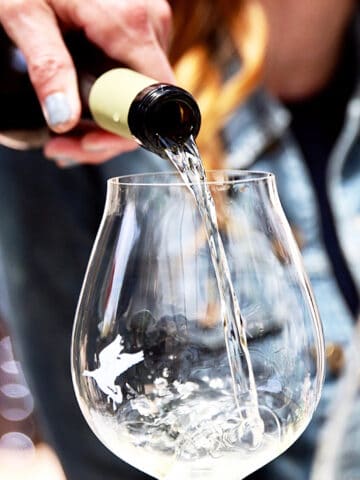Prosecco can be a popular alternative to Champagne or other sparkling wines. But how long does Prosecco last, both before and after you open it? Here’s how to store it properly so it stays good for longer.

Prosecco is increasingly a mainstay at celebrations or special occasions. In fact, about 640 million bottles are sold worldwide each year.
Wine drinkers in the United States alone now consume about 20% of the world’s total Prosecco production. And imports of Prosecco to the U.S. have increased by 40% since 2109.
Part of that is due to cost. But this Italian sparkling wine is much more than just an affordable alternative to a bottle of Champagne.
Jump to:
What is Prosecco?
Prosecco has its roots in Italy’s Veneto region, and it’s produced with the Glera white wine grape variety. Most of the bubbly wine is made either sparkling or semi-sparkling, or spumante and frizzante, respectively.
The wine can range from Brut to Extra Dry to Dry in style, with Brut actually being the dryest, containing the least amount of residual sugar content. Even so, Prosecco’s fruity flavor profile usually contains notes of pear, honeydew melon, and honeysuckle, so it can taste slightly sweet.
In terms of texture, it’s light, bubbly, and crisp.
But how long can you expect Prosecco to stay fizzy and delicious, before and after you’ve opened it? Here’s what you need to know to store Prosecco properly, so it lasts as long as possible.
How to store Prosecco

Storing Prosecco properly will help extend its shelf life and make your wine more enjoyable. Here are some best practices to help your Prosecco stay fresher for longer.
Storing unopened Prosecco
Some claim that Prosecco and other sparkling wines should be stored in an upright position prior to opening. That’s because the wine could develop an off-taste if it comes into contact with the cork for too long. Disregard that “advice.”
Cork is used in wine bottles for the very purpose of keeping air out of the bottle and preserving the wine. As the wine makes contact with the cork, the natural material expands, sealing the bottle from outside air exposure.
If the cork is not kept moist by staying in contact with the liquid inside the bottle, it can become brittle and start to crumble. That can allow air to seep into the wine and affect its taste. So, it’s best to store Prosecco on its side.
Prolonged refrigeration can also dry out the cork, so avoid storing Prosecco in a regular fridge long-term.
The best place to store unopened Prosecco for longer periods is in a cool, dry, dark environment like a wine cellar, wine fridge (which is often not as cold as a regular fridge), or even a cool pantry.
Storing opened Prosecco
Like other sparkling wines, Prosecco is best consumed soon after it’s opened. That’s because once the cork is popped, the fizzy carbonation starts to decrease.
Generally, Prosecco will last about 1 day without going flat after opening. You may be able to extend that to another day if you use a wine stopper or champagne stopper. It’s best to store it in the fridge, as this will keep the wine cool and can help maintain carbonation for longer.
After that though, open Prosecco will usually lose its carbonation and the flavor will start to become less pronounced as well.
How long does Prosecco last unopened?
An unopened bottle of Prosecco will typically keep for up to 3 years if stored properly. While it won’t necessarily go bad after that time, it can start to lose its carbonation and flavor. For that reason, Prosecco usually isn’t stored and aged for long periods.
You can store unopened Prosecco bottles in the fridge for up to a month. After that, the dry cool environment can start to affect the cork in the bottle and allow air to get in. That can allow odors from other foods in the fridge to seep in and affect the taste of the wine.
How long does Prosecco last opened?
In general, opened Prosecco will stay good for about 1 day in the fridge. Much longer than that and the wine loses its bubbles and flavor.
If you don’t think you’ll be able to finish a full-sized bottle of Prosecco wine within a day of opening, consider buying a half bottle or even a “split” (quarter bottle) so you don’t waste any of your leftover Prosecco!
How do I tell if Prosecco has gone bad?
Prosecco won’t necessarily spoil if stored improperly, but the taste and texture can be negatively affected.
Some tell-tale signs that your Prosecco may be past its prime are smell, color, and texture.
If you notice a musty smell, that may mean the cork has been compromised. That in turn can make the wine taste musty or moldy.
A fresh glass of Prosecco should be a light or pale yellow. If the color is a dark yellow or brown, then your wine may no longer be good.
And if your Prosecco has lost its carbonation, it will no longer be pleasurable to drink. This could indicate that it was stored in the fridge too long after being opened, or simply left opened at room temperature.
In any of these cases, it’s a good idea to simply discard the wine.
How is Prosecco different from Champagne?

Only wine produced in the Champagne region of France can be called Champagne. While Prosecco is made in Italy, there are other significant differences between these types of wine.
- Like Champagne, Prosecco is an effervescent wine, but the bubbles in Prosecco are larger and lighter (due to the Charmat method or Tank method of fermentation and aging). Some say that can make it less enjoyable to drink than Champagne, which has finer bubbles. But others contend that larger bubbles can actually improve the taste of sparkling wine.
- Prosecco is often not as dry as Champagne. It’s less common to find extra brut styles of Prosecco, for example.
- Champagne often will cost more than Prosecco. This is due in part to the more labor-intensive production process used to make Champagne. But Champage’s reputation as a more luxury product also plays a role in its higher price.
How to serve Prosecco

Prosecco is best served chilled at an ideal temperature of around 40°-45° Fahrenheit (4.5°-7° Celsius). So transfer it from your pantry to the fridge or an ice bucket about 30 minutes before you plan to serve it. Keeping it cold will help preserve the carbonation and flavor of the Prosecco.
Serving it in a tall tulip wine glass will also help keep the wine effervescent for longer and help maintain its delicate aroma.
FAQ
It stands for Designation of Controlled and Guaranteed Origin. It refers to the areas of Prosecco production that signify the best quality. A lower designation is DOC. That’s a designation of controlled origin that isn’t guaranteed by the Italian government to be in the same special quality class as DOGC wines.
From driest to sweetest levels, Prosecco DOC comes in the following grades: Brut, Extra Dry, Dry and Demi-Sec.
The bottom line
Prosecco can be a great and more affordable alternative to Champagne — and you can find good-quality bottles for $15 to $20 at grocery stores or wine shops. The key to making this popular wine last at home is storing it properly.
If kept in a cool, dry place out of direct sunlight, unopened Prosecco can last up to 3 years. But once it’s opened, your Prosecco will typically stay good for only about a day in the fridge.
More wine-related answers
Looking for more answers to your wine questions? Check out these links below.






Leave a Reply